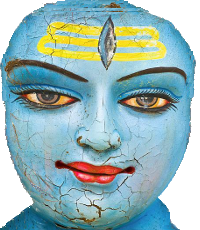The Mughal Empire
Between the tenth and the twelfth centuries, another great wave of invasions swept down on northern parts of the Indian subcontinent. Once again it was a question of nomads coming from Central Asia, but this time they were Muslims who spoke a Turkic language. Between 1206 and 1526, a Muslim state — the Sultanate of Delhi — dominated much of northern India. Here Indian traditions mixed with Islam and new contacts developed between India and the thriving, if politically fragmented, Abbasid Caliphate.[Read more: “The Umayyads and the Abbasids”] The Delhi sultanate was one of the few states that successfully defended itself against the Mongols. As former raiders on horseback themselves, they clearly knew how to deal with them.
The Sultanate of Delhi was weakened by uprisings and eventually, it was overthrown. Yet the rulers who overthrew them too had their origin in Central Asia. The Mughal Empire, 1519-1857, was a Muslim kingdom that started out in today’s Uzbekistan. Its first ruler, Babur, 1526-1530, was a thirteenth-generation descendant of Genghis Khan’s son Chagatai and also a relative of Timur Lenk, who had created a vast, if short-lived, empire in Central Asia in the fourteenth century. Babur tried his best to live up to the traditions of his family. Born in the fertile Fergana Valley in today’s Uzbekistan, he settled in Samarkand where he surrounded himself with a small band of retainers. Pushed out of Samarkand by the advancing Uzbeks, he moved on to Afghanistan and eventually settled in Kabul. From here his armies began making incursions in India. The Mughal soldiers used guns to great effect. Historians sometimes talk about the “gunpowder empires” of Asia — which in addition to the Mughals included the Ottomans and the Safavids of Persia.[Read more: “The Ottoman Empire“] But Babur’s battle tactics also explain much of his success. While guns had been used in India before, they had never been combined with a rapidly moving cavalry. The Indian defenders were amused at our muskets, Babur recalled in his autobiography, but they stopped making jokes when they saw what our weapons could do. Already from the beginning, Babur treated the people of India leniently, more as his subjects than as his prey. And yet, he remained homesick for Samarkand until the end of his life.
There were eighteen subsequent rulers of the Mughal Empire. Babur was succeeded by his son, Humayun, 1530-1540 and 1555-1556. His name means “the lucky one,” but he was clearly quite inappropriately named. He lost the Mughal throne and was exiled to Iran, but with Persian support he eventually reconquered it. Humayun died, only forty-eight years old, when falling down a staircase — according to one version, while running to get to Friday prayer on time. After his unexpected death, it was unclear who would succeed him, but eventually, his son Akbar, 1556-1605, did. Akbar was thirteen years old at the time and he was to rule India for the next fifty years. Akbar was the emperor who more than all others put his mark on the empire. When he captured the state of Gujarat in 1573 — a major victory — he was only thirty-one years old. This was a time of great expansion in world trade, and Mughal India was its hub. [Read more: “A mountain of silver“] Akbar loved hunting, horse riding, and archery, and although he remained illiterate all his life, he had a library of some 24,000 volumes written in Sanskrit, Urdu, Persian, Greek, Latin, and Arabic. Persian culture was influential at Akbar’s court, with Persian-style music, poetry and illuminated manuscripts as primary art forms.
Akbar’s oldest son Jahangir, 1605-1627, replaced him in 1605. Jahangir means “conqueror of the world” and he tried his best to live up to the name, although to posterity he is more remembered for his active love life. The economy of the country remained strong and so did the Mughal administration. He too encouraged religious debates and tolerance of other faiths. Shah Jahan, 1628-1658, was Akbar’s grandson. He took an interest in architecture and left a number of prominent buildings to posterity. He constructed the Red Fort in Delhi and made Agra into his capital. It was also he who commissioned the Taj Mahal as a monument to commemorate Mumtaz, his beloved wife. In addition, Shah Jahan is famous for the Peacock Throne and the Koh-i-Noor diamond. It was on the Peacock Throne, in the Red Fort, that the Mughal emperors were seated on ceremonial occasions. The Peacock Throne is said to have cost twice as much as the construction of the Taj Mahal itself.
The fourteen subsequent emperors were less distinguished and less colorful. A particularly controversial ruler was Aurangzeb, 1658-1707. The empire continued to expand during his reign and the economy remained strong. The Mughal Empire at the time had some 150 million subjects and an economy responsible for perhaps a quarter of world output. But relations between the Muslim rulers and their Hindu subjects deteriorated. Aurangzeb reintroduced the jizya and he was notorious for destroying Hindu temples. During the rule of his descendants, the Mughal hold on the country weakened considerably. There were revolts against higher taxes and discontent regarding religious matters. Various regional rulers rose up to compete with the imperial center. This was also when the next wave of invaders appeared, this time traveling by boat. The first Europeans to arrive were the Portuguese; then came Holland, France and eventually the agents of the British East India Company. This, however, is a story to which we will return in our last chapter. [Read more: “The European expansion”]



